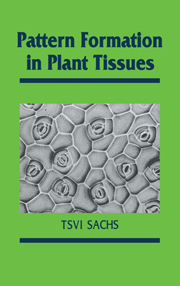Crossref Citations
This Book has been
cited by the following publications. This list is generated based on data provided by Crossref.
Cline, Morris G.
1991.
Apical dominance.
The Botanical Review,
Vol. 57,
Issue. 4,
p.
318.
Sachs, Tsvi
1991.
Cell polarity and tissue patterning in plants.
Development,
Vol. 113,
Issue. Supplement_1,
p.
83.
GERSANI, M.
and
SACHS, T.
1992.
Development correlations between roots in heterogeneous environments.
Plant, Cell & Environment,
Vol. 15,
Issue. 4,
p.
463.
Beneš, Karel
1992.
T. Sachs pattern formation in plant tissues.
Folia Geobotanica et Phytotaxonomica,
Vol. 27,
Issue. 2,
p.
192.
Dale, John E.
1992.
How Do Leaves Grow?.
BioScience,
Vol. 42,
Issue. 6,
p.
423.
Mohr, Hans
and
Schopfer, Peter
1992.
Pflanzenphysiologie.
p.
295.
CLOWES, F. A. L.
1992.
Regeneration of the discrete root epidermis of Pistia stratiotes L. after perturbation of the meristem.
New Phytologist,
Vol. 120,
Issue. 2,
p.
209.
SACHS, T.
NOVOPLANSKY, A.
and
COHEN, D.
1993.
Plants as competing populations of redundant organs.
Plant, Cell & Environment,
Vol. 16,
Issue. 7,
p.
765.
SACHS, T.
and
NOVOPLANSKY, N.
1993.
The development and patterning of stomata and glands in the epidermis of Peperomia.
New Phytologist,
Vol. 123,
Issue. 3,
p.
567.
ELEFTHERIOU, E. P.
1993.
Differentiation of abnormal sieve elements in roots of wheat (Triticum aestivum L.) affected by colchicine.
New Phytologist,
Vol. 125,
Issue. 4,
p.
813.
Chen, Yongning
and
Li, Wenan
1993.
Floral gradient in flowering tobacco in relation to free amino acids.
Cell Research,
Vol. 3,
Issue. 1,
p.
85.
Raju, Manjarabad V. S.
and
Marchuk, William N.
1993.
Xylem changes in the correlative inhibition of lateral bud growth in flax (Linum usitatissimum L.).
Journal of Plant Research,
Vol. 106,
Issue. 2,
p.
137.
Douady, Stéphane
and
Couder, Yves
1993.
Growth Patterns in Physical Sciences and Biology.
Vol. 304,
Issue. ,
p.
341.
Schmid, Bernhard
and
Weiner, Jacob
1993.
PLASTIC RELATIONSHIPS BETWEEN REPRODUCTIVE AND VEGETATIVE MASS IN SOLIDAGO ALTISSIMA
.
Evolution,
Vol. 47,
Issue. 1,
p.
61.
Warren Wilson, J.
Keys, W. M. S.
Warren Wilson, P. M.
and
Roberts, L. W.
1994.
Effects of auxin on the spatial distribution of cell division and xylogenesis in lettuce pith explants.
Protoplasma,
Vol. 183,
Issue. 1-4,
p.
162.
Meagher, Richard B.
1995.
Evolutionary Biology.
p.
195.
Yeung, Edward C.
1995.
In Vitro Embryogenesis in Plants.
Vol. 20,
Issue. ,
p.
205.
Sachs, Tsvi
and
Novoplansky, Ariel
1995.
TREE FORM: ARCHITECTURAL MODELS DO NOT SUFFICE.
Israel Journal of Plant Sciences,
Vol. 43,
Issue. 3,
p.
203.
Mohr, Hans
and
Schopfer, Peter
1995.
Plant Physiology.
p.
285.
Hammer, Samuel
1995.
Primary tissue and the structure of the podetium inCladonia.
Mycologia,
Vol. 87,
Issue. 1,
p.
46.



